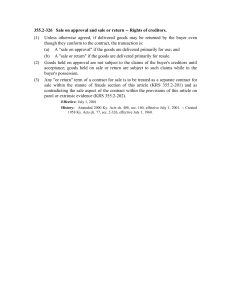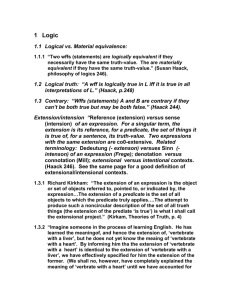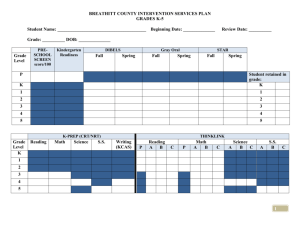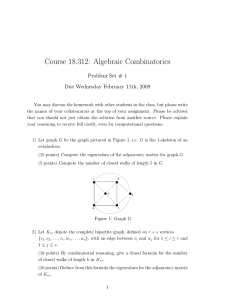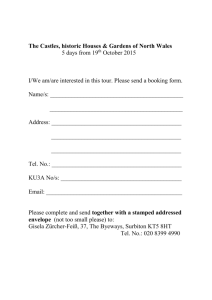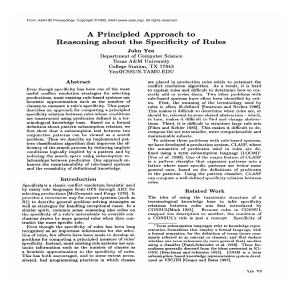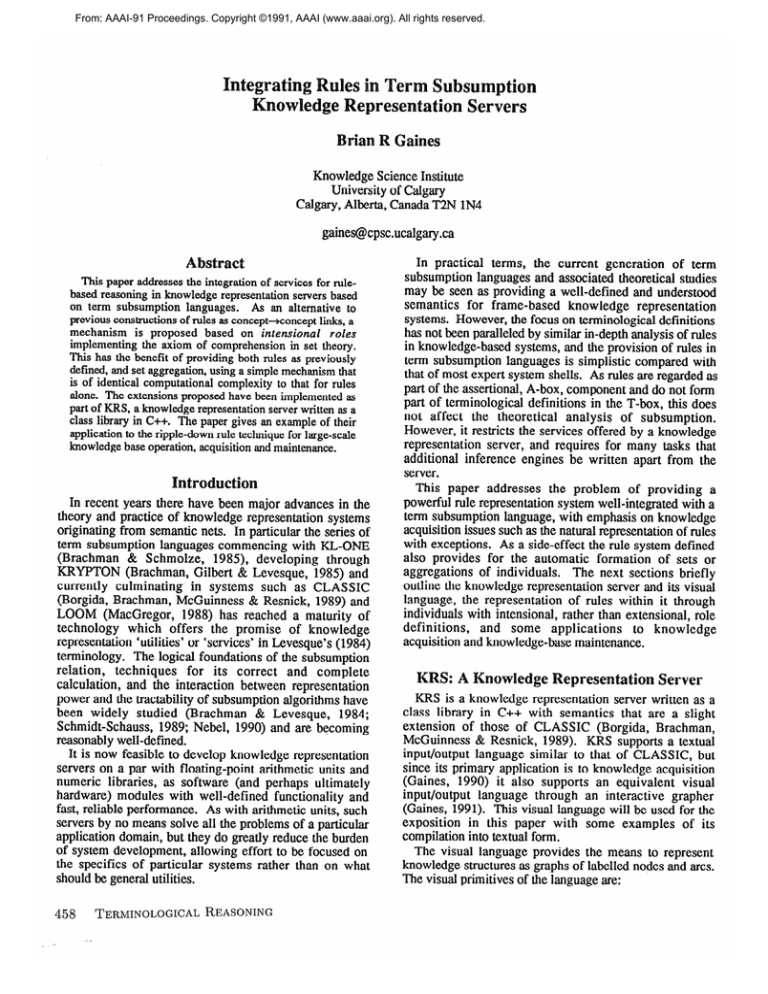
From: AAAI-91 Proceedings. Copyright ©1991, AAAI (www.aaai.org). All rights reserved.
Knowledge Science Institute
University of Calgary
Calgary, Alberta, Canada T2N lN4
gaines@cpsc.ucalgary.ca
This paper addresses the integration of services for rulebased reasoning in knowledge representation servers based
on term subsumption
languages.
AS an alternative to
previous constructions of rules as concept+concept
links, a
mechanism
is proposed
based on intensional
roles
implementing
the axiom of comprehension
in set theory.
This has the benefit of providing both rules as previously
defined, and set aggregation, using a simple mechanism that
is of identical computational
complexity to that for rules
alone. The extensions proposed have been implemented as
part of KRS, a knowledge representation server written as a
class library in C++. The paper gives an example of their
application to the ripple-down rule technique for large-scale
knowledge base operation, acquisition and maintenance.
ntroduction
In recent years there have been major advances in the
theory and practice of knowledge representation systems
originating from semantic nets. In particular the series of
term subsumption languages commencing with KL-ONE
(Brachman Jz Schmolze, 1983, developing through
KRYPTON (Brachman, Gilbert & Levesque, 1985) and
currently culminating in systems such as CLASSIC
(Borgida, Brachman, McGuinness & Resnick, 1989) and
LOOM (MacGregor, 1988) has reached a maturity of
technology which offers the promise of knowledge
representation ‘utilities’ or ‘services’ in Levesque’s (1984)
terminology. The logical foundations of the subsumption
relation, techniques for its correct and complete
calculation, and the interaction between representation
power and the tractability of subsumption algorithms have
been widely studied (Brachman & Levesque, 1984;
Schmidt-Schauss, 1989; Nebel, 1990) and are becoming
reasonably well-defined.
It is now feasible to develop knowledge representation
servers on a par with floating-point arithmetic units and
numeric libraries, as software (and perhaps ultimately
hardware) modules with well-defined functionality and
fast, reliable performance. As with arithmetic units, such
servers by no means solve all the problems of a particular
application domain, but they do greatly reduce the burden
of system development, allowing effort to be focused on
the specifics of particular systems rather than on what
should be general utilities.
458
TERMINOLOGICAL REASONING
In practical terms, the current generation of term
subsumption languages and associated theoretical studies
may be seen as providing a well-defined and understood
semantics for frame-based knowledge representation
systems. However, the focus on terminological definitions
has not been paralleled by similar in-depth analysis of rules
in knowledge-based systems, and the provision of rules in
term subsumption languages is simplistic compared with
that of most expert system shells. As rules are regarded as
part of the assertional, A-box, component and do not form
part of terminological definitions in the T-box, this does
not affect the theoretical analysis of subsumption.
However, it restricts the services offered by a knowledge
representation server, and requires for many tasks that
additional inference engines be written apart from the
server.
This paper addresses the problem of providing a
powerful rule representation system well-integrated with a
term subsumption language, with emphasis on knowledge
acquisition issues such as the natural representation of rules
with exceptions. As a side-effect the rule system defined
also provides for the automatic formation of sets or
aggregations of individuals. The next sections briefly
outline the knowledge representation server and its visual
language, the representation of rules within it through
individuals with intensional, rather than extensional, role
definitions,
and some applications
to knowledge
acquisition and knowledge-base maintenance.
egresentation
KRS is a knowledge representation server written as a
class library in C++ with semantics that are a slight
extension of those of CLASSIC (Borgida, Brachman,
McGuinness & Resnick, 1989). KRS supports a textual
input/output language similar to that of CLASSIC, but
since its primary application is to knowledge acquisition
(Gaines, I990) it also supports an equivalent visual
input/output language through an interactive grapher
(Gaines, 1991). This visual language will be used for the
exposition in this paper with some examples of its
compilation into textual form.
The visual language provides the means to represent
knowledge structures as graphs of labelled nodes and arcs.
The visual primitives of the language are:
The visual language provides the means to represent
knowledge structures as graphs of labelled nodes and arcs.
The visual primitives of the language are:
Nodes, identified and typed as specified below.
0 Two arc types linking nodes-a line with, and without, an
arrow, respectively.
0 Text strings labelling the nodes-with
an associated
equivalence relation based on lexical identity.
0 Five distinctive text surrounds defining the node typesovals (concepts), marked ovals (primitives), rectangles
(individuals), no surround (roles or annotation), and
marked rounded corner rectangles (constraints, e.g.
cardinality and set inclusion).
The semantics of the arc types are overloaded and
determined by the nodes joined. A line between two
primitive nodes defines them as disjoint, for example,
l
, and between two roles defines
ch I I d . An
them as inverse, for example, par en t arrow from one concept to another defines the first as
subsumed by the second; from a concept to a role, that the
role is part of the definition of the concept, etc. The graph
at the top of Figure 1 shows the way in which concepts are
defined and constraints and values asserted for individuals
in the visual language. The resultant text statements are
shown at the bottom.
age
w
height
-b&j
Primitive(person)
Primitive(patient, person,
(All age, (One young, old))
(All height, (Integer 1 OS100))
1
Concept(old patient, patient,
(All age, (Include old))
Integration of Rules
CLASSIC (Borgida, Brachman, McGuinness & Resnick,
1989) and LOOM (MacGregor, 1988) provide a basic form
of rule in which the two concept definitions are linked in
such a way that recognition of an individual as satisfying
the constraints of the first concept leads to the assertion that
it satisfies the constraints of the second. For example, if
the following rule is added to the graph of Figure 1:
risk
and the inference engine is run then the individual Fred will
be recognized as an “old patient” and the constraint will be
asserted will be made that the role “risk” for Fred includes
“pneumonia.”
The incorporation of rules as asserted concept+concept
links integrates well with the way in which definitions in
the T-box classify assertions in the A-box: if an individual
is classified as falling under the first concept it is asserted
to fall under the second; the first concept definition may be
seen as specifying sufficient conditions for classification,
and the second concept as additional necessary conditions.
McGregor (1988) has shown how such rules may be used
to recognize recursive structures such as lists, and Figure 2
shows his construction in the visual language.
The
individual “~2” is recognized to be a “cons list” because it
is asserted to be a “cons” and its cdr, “null”, is asserted to
be a “list”. Hence, c2, through the rule, is asserted to be
itself a “list”. Then the individual “cl” is similarly
recognized as a “cons list” because its cdr, W”, has been
asserted to be a “list”.
Fig.2 Recognition of a recursive structure using a rule
It may appear that a major limitation of this form of rule
is that, since a single individual is classified at a time, it
corresponds to an OPSS-style rule with only one free
variable (McGregor, 1988). However, since the roles of an
individual may be filled with other individuals, a rule
classifying one individual may involve classifying, and
making assertions about, several individuals. For example
the rule with two free variables: ((data ?d) (clock ?c)
(connected ?d ?c) + (connection-error ?d ?c)) in CADIE
(Franke, 1990), has an equivalent in KRS as shown in
Figure 3.
1
Individual(Fred, patient,
(Fills age, old)
(Fills height, 72)
1
Fig.1 Definitions and assertions in KRS visual and text
languages
Fig.3 Rule with two free variables
GAINES
459
If an individual that is asserted to be a “clock” is asserted
to be “connected” to one that is asserted to be “data” then
both individuals are asserted by the rule to have a
“connection error”. This construction in general clearly
depends on the roles linking the free variables and would
not be applicable to a rules whose premise references
several completely independent individuals. However, this
may be seen as a desirable constraint on rules integrated
with frame-based knowledge representation schema-that
a frame should exist, or be created, which brings into
relation individuals accessed by the premise of a rule.
ules through Aggregation
There is a more subtle criticism that can be made of the
way in which rules are introduced into term subsumption
languages. A rule is introduced as a new construct which
links two concepts.
It acts as an inferred assertion
involving the classification of all individuals in the domain
by the concepts that form the premise of a rule. However,
the sets of individuals resulting from this classification are
lost except in so far as it results in individuals being reclassified by the conclusion of the rule. There is a need in
many applications of term subsumption languages for an
aggregation operation that forms sets in a natural way
(Allgayer & Reddig-Siekmann, 1990), and it is attractive to
consider an alternative way of incorporating rules as the
side effect of such aggregation.
The definition of role fillers is normally extensional in
that specific individuals are named as fillers. Suppose one
introduces a complementary
way of filling a role
intensionaZZy by defining the concept which a role filler
must satisfy and specifying that all individuals in the
domain that satisfy it are fillers. This operationalizes
Frege’s axiom of abstraction or comprehension, that every
concept defines a set. Introducing intensional role filling
instead of rules as a new construct has the advantage of
providing an explicit aggregation operator. Rules can be
realized as a natural side-effect of the individuals actually
being asserted to be in the intensional role. That is, the
premise of the rule is now the intensional role definition,
and the conclusion is the intensional role constraint.
As a first step to an aggregation operation, consider how
Frege’s axiom can be represented using inverse roles.
Figure 4 shows a concept “intension x” whose role
“member of’ includes “extension x” whose role “member”
is inverse to “member of” and constrained by “intension x”.
An individual asserted to be an “intension x” will be
inferred to fill the “member” role of “extension x”, and,
conversely, an individual asserted to fill the “member” role
of “extension x” will be inferred to be an “intension x”.
nenber
nenber
Fig.4 Axiom of comprehension with inverse roles
460
TERMINOLOGICAL REASONING
This construction is available in existing knowledge
representation systems. For example, in LOOM, it is:
(defconcept intension-x :is (filled-by (:inverse member)
extension-x))
The assertions of conceptual constraints on individuals:
(tell (intension-x indl))
(tell (intension-x ind2))
then result in the query about members of extension-x:
(retrieve ?I (member extension-x ?I))
returning indl and ind2 as required.
The construction of Figure 4 is readily extended to have
the side effect required for rules by having the arrow from
“member” go, not to “intension x”, but instead to another
concept, “intension y” say, representing the conclusion of
the rule. However, inverse roles alone cannot implement
intensional role filling since it is still necessary to make the
explicit assertion that an individual is an “intension x”
rather than recognize this as being so.
Figure 5 shows how intensional role filling is introduced
in KRS as a link from a concept, “intension x”, to an
individual, “extension x”. This results in the inference
engine aggregating the set of all individuals in the domain
that are recognized as “intension x” and filling the
“member” role of “extension x” with them. If the
“member” role is constrained by a concept, “intension y”,
this also results in all the individuals recognized as
“intension x” being additionally asserted to be “intension
y”, thus implementing a rule.
member
Fig.5 Intensional role, aggregation individual and rule
Intensional roles are proposed as a preferred alternative
to concept+concept rules in term subsumption languages.
They provide set aggregation and rules in one construct.
Implementation in the inference engine involves no more
computation than for rules alone. The additional storage
space for the aggregations has not proved a significant
overhead in a wide range of applications of KRS. Note that
a “rule” in KRS is represented as an individual with an
intensional role, and that the individual can have additional
roles, and can itself be used as a role filler in other
individuals. The availability of these features and explicit
aggregations has proved invaluable in applications
involving planning, configuration and scheduling.
Rules with Exceptions
A limitation of the rule schema described above is that
they make no provision for the representation of rules with
exceptions. Logically, if one does not require default
reasoning, rules with exceptions can always be expanded
into an equivalent, although generally larger, set of rules
without exceptions. However, in knowledge representation
for knowledge acquisition systems in particular, it is
important to be able to encode expert knowledge in exact
conformity with the expert’s representation, which is often
as a rule with exceptions. Hence, KRS offers a further
extension in which one rule can be an exception to others.
As shown in Figure 6, an arrow from one individual to
another means that the first individual acts as an exception
in aggregation to the second. That is, that individuals are
aggregated in the “member” role of the “aggregation rule”
if they are classified as “premise rule” but not as “premise
exception”. Thus the exception mechanism provides for
both exceptions to rules and differential aggregations.
Since one individual may be an exception to many others,
and may have many exceptions to itself, complex structures
are readily represented. To reduce the number of arrows
the exception arrow is taken to be transitive, so that an
individual is an exception to all those individuals along its
outgoing paths of exception arrows.
member
is open in recognition for an intensional role this acts as
false as far as placing it in the role is concerned but as true
as far as exception propagation is concerned. Thus, the
basic inference engine acts as a conservative, monotonic,
reasoner in worlds where some roles or fillers are open.
It also supports a simple extension of the exception
scheme to default reasoning in that the inference engine
generates a list of open concept-individual pairs. Nonmonotonic inference can commence with the default
assumption that none of the open pairs will become true
and hence not propagate open exceptions. If this leads to a
consistent world it is the unique default extension. If it
does not, a truth maintenance search can be invoked for
maximal subsets of the open pairs that can be assumed
false, resulting in zero to a number of possible extensions.
renber
Fig.6 Representation of a rule with an exception
Figure 7 shows the solution to Cendrowska’s (1987)
contact lens problem represented in KRS as a set of two
rules with three exceptions. This compares favorably with
the minimal solution without exceptions, of nine rather
more complex rules.
The implementation of intensional roles, aggregations,
rules and exceptions in KRS is more subtle than has been
indicated because no closed-world assumptions are made.
Hence subsumption and recognition return one of three
values, true, false or open, that is able to become either
true or false as more assertions are made. If an individual
Pat i
Compton and Jansen (1990) have developed techniques
for the acquisition and maintenance of large rule-based
systems. They have applied their “ripple-down rule”
techniques to the Garvan ES-l knowledge base for thyroid
diagnosis, which has grown to a size and complexity where
it has become difficult to maintain.. The techniques rely on
the efficient management of rules with a large number of
exceptions,
and the acquisition
and maintenance
procedures require access to aggregations of previously
classified cases. Hence they provide a useful test of KRS
capabilities in a domain where ongoing maintenance
through continual knowledge acquisition is important, and
where large rule sets and case bases are available.
ent
Defini
Fig.7 Solution to contact lens problem through rules with exceptions
G AIN‘ES
461
The acquisition and maintenance procedures assume that
an expert is available to make decisions about changes in
the knowledge base. The objective of the ripple-down rule
representation is to simplify the expert’s task by allowing a
new rule to be entered for a misdiagnosed case through a
simple procedure that has only to take account of one
existing rule and the cases that have already fallen under it.
That is, the activities take place in a minimal context with a
guarantee that no change will be made to the system’s
behavior outside that context.
Consider an empty knowledge base in which information
about an individual “case 0” has been entered with a known
diagnosis “diagnosis b”. The expert creates a concept,
“concept j”, that will recognize “case 0” and attaches it to a
rule, “rule j”, that leads to “diagnosis b”. Figure 8 shows
the resultant state of the knowledge base.
member
case
L?l 0
Fig.8 Initial case and rule entered in ripple-down rule
base
Now consider the entry of further cases. If a case is
identical to an existing one but has a different diagnosis
then there is a conflict, otherwise there are four
possibilities:
1. “Case 1” is identical to “case 0” and has same diagnosis.
There is no need for a new rule or for the entry of the
case.
2. “Case 2” falls under “concept j” and has “diagnosis b”
but is not identical to “case 0”. There is no need for a
new rule but the case needs to be entered.
3. “Case 3” does not fall under “concept j” and has
“diagnosis c”. The expert proposes a new covering
concept, “concept k”, and rule, “rule k”, following the
same procedure as for “case 0”. The existing rule, “rule
j”, is made an exception to this new rule.
4. “Case 4” falls under “concept j” but has a different
diagnosis, “diagnosis a”. A new rule is created by
adding constraints to “concept j” that apply to “case 4”
but not to “case 0” to create “concept i” subsumed by
“concept j”. The resultant “rule i” with “diagnosis a” is
entered as an exception to “rule j”.
Figure 9 shows the state of the knowledge base after this
procedure has been followed.
Compton and Jansen’s insight was that the procedure
described could be repeated indefinitely as more cases are
entered. It leads to a linear chain of rules such that a case
may be seen as being entered at the beginning of the chain
and rippling up (or “down’‘-KRS
arrows are in the
o;>posite direction to the original implementation diagrams)
until it is recognized by the premise of a rule. The
diagnosis is then determined by the conclusion of the rule.
462
TERMINOLOGICAL REASONING
member
member
member
Fig.9 Ripple-down rule base after initial case entries
In knowledge
acquisition
and knowledge-base
maintenance, if the case does not fall under any rule, a new
one is created at the end of the chain as for “case 3” above.
If it comes under a rule with an incorrect diagnosis, a new
one is created with a premise that is subsumed by that of
the existing rule and does not cover any of the cases that
have already been diagnosed using the existing rule. This
new rule is inserted in the chain as an exception to the one
with the incorrect diagnosis.
A new rule can always be created using these procedures
since a concept may be created that has precisely the
constraints necessary to recognize uniquely the new case.
However, the expert will often be able to generalize such a
specific concept and, in so doing, need only consider
discriminating the previous cases attached to the one rule.
The KRS rule mechanism supports both the chain of
exceptions and the case aggregation required for rippledown rules. The ripple-down version of the Garvan rules,
547 rules, together with 669 cases evaluated on 17
attributes, were loaded and run in KRS on a Macintosh II.
The diagnoses took 0.4 seconds a case on average. Thus,
even a microcomputer is able to support a significantly
large knowledge-base
operation,
acquisition
and
maintenance using the ripple-down rules technique.
On obvious question regarding knowledge bases created
through the ripple-down rules technique is the sizeefficiency of the resultant knowledge base. Since rules,
once entered, are not changed, if the expert overgeneralizes or over-specifies, more rules will be generated
than needed. Clearly size-efficiency is an empirical issue
that can only be investigated over a number of knowledge
bases created by different experts. When the data set of
669 cases are run through Induct (Gaines, 1989), an
empirical induction algorithm that generates rules from
cases with similar efficiency to C4.5 (Quinlan, 1987), a
rule set giving correct diagnoses with 269 rules is
generated, that is a reduction by about 50%. The resultant
rule set, while smaller, may not be as understandable or
acceptable as knowledge structure, and this is subject to
further empirical investigation.
Conclusions
Developments in the theory and practice of term
subsumption languages make possible generic knowledge
representation servers offering efficient implementation of
principled artificial intelligence techniques.
This paper has addressed the issue of integrating services
for rule-based reasoning with knowledge representation
servers based on term subsumption languages. As an
alternative to previous constructions of rules as concept
*concept links, a construction based on intensional roles
is proposed. This has the benefit of providing rules as
previously defined, and set aggregation, with a simple
mechanism that is of identical computational complexity to
that for rules alone. This mechanism extends simply to the
representation of rules with exceptions.
It is interesting to examine what representational issues
in the A-box are addressed by the new constructs. The
exception mechanism itself implements concept negation in
rule expression. In addition, since multiple concepts can
point to the same aggregation individual, disjunctive rules
can be expressed. These mechanisms also provide for the
formation of set aggregations on a differential basis,
essentially introducing concept disjunction and negation in
both rules and set aggregation in the A-box.
The computational
cost of the intensional role
aggregation operation is identical to that of the rule
mechanism it replaces. Intensional roles are processed
exactly as if they were the premises of rules. The
subsumption lattice that is computed as part of the KRS
implementation of a term subsumption language is used to
ensure very rapid recognition of those individuals which
fall under the concept defining an intensional role The
exception links are processed quite separately after such
recognition in a time that is negligible compared with the
recognition itself.
The extensions proposed have been implemented as part
of KRS, a knowledge representation server written as a
class library in C++. The paper gives an example of their
application to the ripple-down rules technique for largescale knowledge base operation,
acquisition
and
maintenance, and some evaluation of the space/time
performance on the Garvan ES-l knowledge-base.
eferences
Allgayer, J. & Reddig-Siekmann, C. 1990. What KL-ONE
lookalikes need to cope with natural language. Bltisius,
K.H., Hedsttick, & Rollinger, C.-R., Eds. Sorts and Types
in Artficial Intelligence. pp.240-285. Berlin: Springer.
Borgida, A., Brachman, R.J., McGuiness, D.L. & Resnick,
L.A. 1989. CLASSIC: a structural data model for objects.
Clifford, J., Lindsay, B. & Maier, D., Eds. Proceedings of
1989 ACM SIGMOD International Conference on the
Management of Data. pp.58-67. New York: ACM Press.
Brachman, R. J., Gilbert, V.P. & Levesque, H. J. 1985. An
essential hybrid reasoning system: knowledge and symbol
level accounts of KRYPTON. Proceedings of IJCAI85.
pp.547-55 1. Morgan Kaufmann.
Brachman, R. J., & Levesque, H. J. 1984. The tractability
of subsumption in frame-based description languages.
Proceedings of AAAI-84. pp.34-37. Morgan Kaufmann.
Brachman, R.J. & Schmolze, J. 1985. An overview of the
KL-ONE knowledge representation system. Cognitive
Science, 9(2) 171-216.
Cendrowska, J. 1987. An algorithm for inducing modular
mles. International Journal of Man-Machine Studies 27
(4), 349-370.
Compton, P. & Jansen, R. 1990. A philosophical basis for
knowledge acquisition. Knowledge Acquisition 2(3), 241258.
Franke, D.W. 1990. Imbedding rule inferencing in
applications. IEEE ETpert, 5(6) 8-14 (December).
Gaines, B.R. 1989. An Ounce of Knowledge is Worth a
Ton of Data: Quantitative Studies of the Trade-Off between
Expertise and Data based on Statistically Well-Founded
Empirical Induction. Proceedings of 6th International
Workshop on Machine Learning, pp. 156- 159. Morgan
Kaufmann
Gaines, B.R. 1990. An architecture for integrated
knowledge acquisition systems. Boose, J.H. & Gaines, B.R.
Eds. Proceedings of the Fifth AAAI Knowledge Acquisition
for Knowledge-Based Systems Workshop. pp. 8-I-8-22.
Banff (November).
Gaines, B.R. (1991). An interactive visual language for
term subsumption visual languages. IJCAI’91: Proceedings
of the Thirteenth International Joint Conference
Artificial Intelligence. Morgan Kaufmann.
This work was funded in part by the Natural Sciences
and Engineering Research Council of Canada. I am
grateful to Ron Brachman and Rob McGregor for access to
their research on term subsumption languages, to Paul
Compton and Bob Jansen for access to their research on
ripple-down rules, to Paul Compton for access to the
Garvan ES- 1 knowledge base, and to Mildred Shaw for
collaborative research on knowledge acquisition systems.
on
Levesque, H. J. 1984. A logic of implicit and explicit
belief. Proc. w-84.
pp.198-202. Morgan Kaufmann.
MacGregor, R.M. 1988. A deductive pattern matcher.
Proceedings of AAA188.pp.403-408. Morgan Kaufmann.
Nebel, B. 1990. Reasoning and Revision in Hybrid
Representation Systems. Berlin: Springer.
decision trees,”
Quinlan, J.R. 1987. “Simplifying
International J. of Man-Machine Studies, 27(3), 221-234.
Schmidt-Schauss, M. 1989. Subsumption in #L-ONE is
undecidable Proceedings of KR’89: First International
Conference on Principles of Knowledge Representation
and Reasoning. pp.421-43 1. Morgan Kaufmann.
GAINES
463


